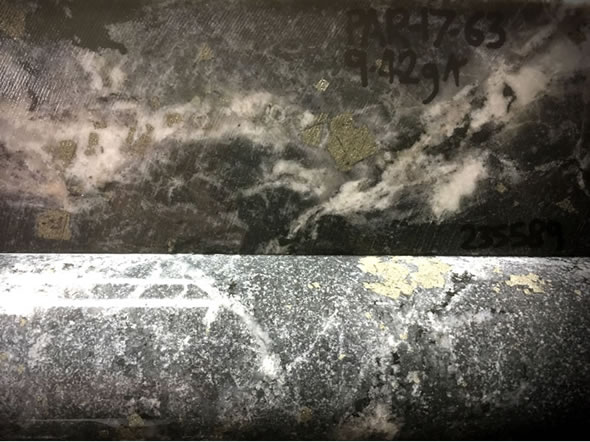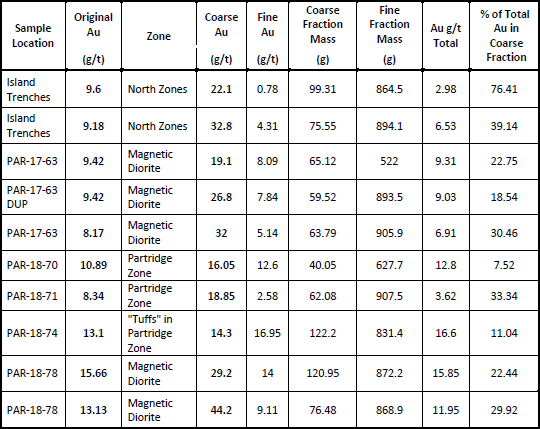Renforth Resources Achieves Significantly Higher Gold Grades at Parbec
Within the rigid scientific approach to exploration activity there is room for a measure of creativity. The technical prowess of a geological team will have a great bearing on the potential for a successful outcome to any exploration program. However, the interpretation of data and the modeling of a system located at great depths below surface may require intuition and alternative strategies to get the best results.
It is quite common for one team of geologists to achieve a notable discovery at the same property where another group had entirely overlooked the same potential deposit. The difference to achieve success is sometimes a matter of the willingness to use a different approach.
Renforth Resources Inc. (CA:RFR – $0.03 & US:RFHRF – $0.03 & GER:9RR – €0.02) has already demonstrated the ability to encounter attractive new gold discoveries that had been entirely overlooked by previous operators. The geological team recently presented exciting new gold zones at the Parbec project. Similar successful advances were reported recently from the 2019 drilling at the New Alger property also.
This more flexible approach also extends to the laboratory analysis process. Alternate methods to complete sample testing have been requested by the Company. This week, Renforth reported that retesting of sample material using Metallic Screening analysis has led to significantly higher gold values than the results previously reported based on fire assay only.
A batch of ten samples was resubmitted using reject sample material returned from the original assay process. The samples were extracted from a variety of different lithologies encountered at Parbec, and each had already been established as gold-bearing from the fire assay testing.

Picture of the actual core from PAR-17-63 at Parbec.
Presence of Coarse Gold Established Through Testing Regime
Two things stand out from this batch of ten sample results. Firstly, all 10 of the samples delivered higher grades from the coarse gold content than was originally reported from the fire assay process. For example, sample 78 from the magnetic diorite rock contained 29.2 g/t coarse gold in comparison to the 15.66 g/t gold reported from the fire assay analysis. A sample selected from the Island Trenches yielded 32.8 g/t gold from metallic screening which was more than three times richer than the 9.18 g/t gold value originally reported. This is extremely encouraging as Renforth is now adjusting its assaying methodology to account for this gold that was not entirely detected in the prior analysis process.
Similar to the encouraging results obtained at the New Alger project, the Company has demonstrated that more representative results may be achieved using the combination of fire assay and metallic screening for sample material. This in turn is also contributing to higher overall gold values for some sections and therefore a larger potential gold resource as the data is eventually incorporated into a compliant resource estimate.

Greater Accuracy Achieved Using Combined Laboratory Analysis Tests
It is important to provide clarity on the reference to ‘reject sample material’ for the purposes of this Metallic Screening process. When samples arrive at the laboratory the rock is pulverized in a grinding process down to a fine powder. Only a small portion of the total sample is selected and submitted for fire assay. The remainder, termed the ‘reject’, is returned to Renforth for secure storage. It is this remaining reject sample material that was resubmitted to ALS Laboratories to enable the Metallic Screening testing process.
There is no perfect method for gold analysis. Fire assay is considered the most efficient method for most types of gold samples. However, coarse gold flakes are not fully reduced down to smaller particle size during the pulverizing of sample rock, and are less likely to pass through the fine mesh screen prior to commencing fire assay testing. Therefore, this contingent of coarse gold is more accurately accounted for through the secondary metallic screening analysis, using approximately one kilogram of the reject sample material.
A second fire assay process was also completed for each sample following the metallic screening work. Final overall sample grades are then calculated using the two data points. The results highlight the effectiveness of the combined approach.
Conclusion
The diligence of the geological team to request alternative analysis methodology is paying dividends for Renforth. By employing Metallic Screening of the sample material, a much higher overall gold content has been identified. This in turn is supporting definition of a more attractive gold deposit as the higher grades contribute to a larger overall resource.
As the discovery process advances towards a potential mine development scenario, the presence of significant coarse gold may also make for a more effective processing solution. Coarse gold may be more efficiently recovered using a primary gravity circuit. Therefore the potential for more economic gold production and higher net recovery may ultimately contribute towards the development of a new gold mine at Parbec.
Now that Metallic Screening has been proven to arrive at a more representative overall grade, the retesting process will be carried out for a larger inventory of reject sample material collected from several of the 37 previously completed drill holes. It is expected that this will yield additional positive results to augment the gold resource from this work. The Company will also conduct future laboratory analysis of all samples to include Metallic Screening for coarse gold. Smallcaps Recommendation: BUY.
| Smallcaps.us Advice: Buy | Price Target: $0.29 | Latest Company Report (pdf) |
| For important disclosures, please read our disclaimer. | ||
